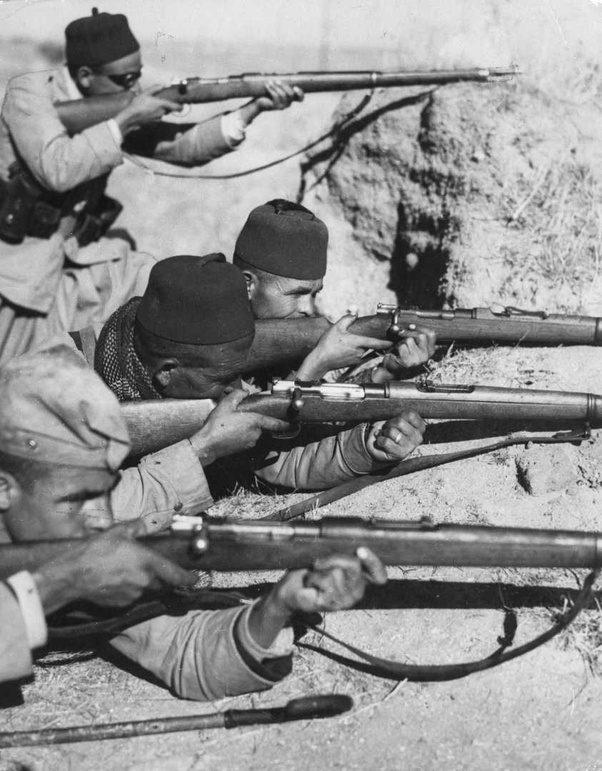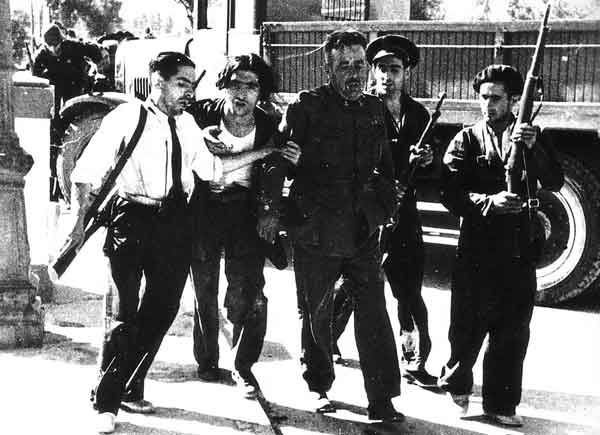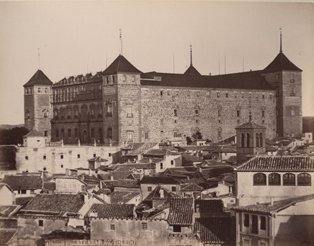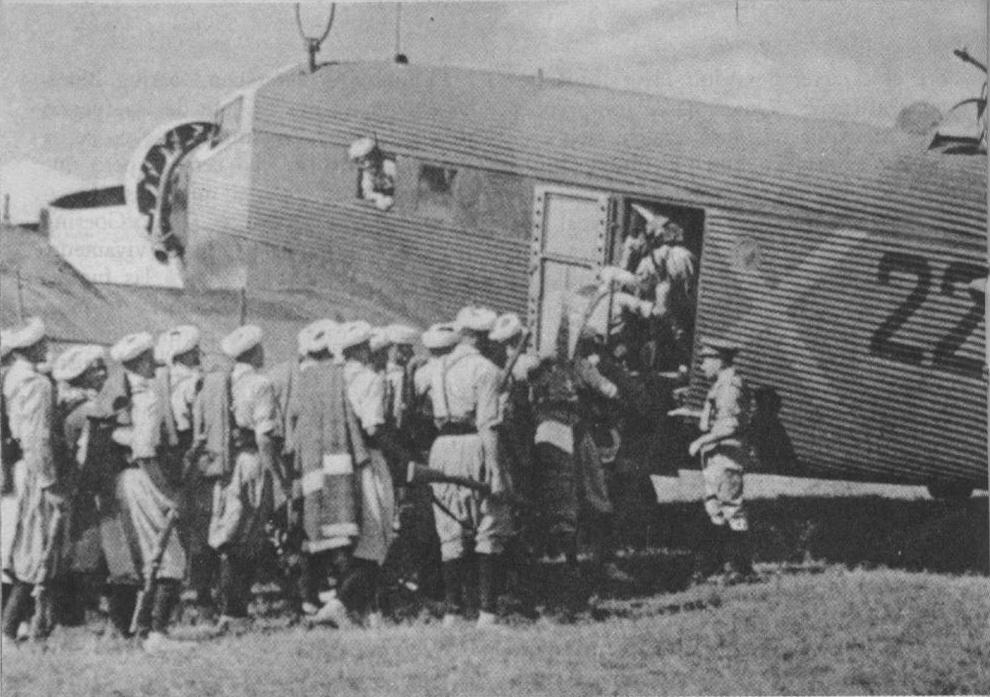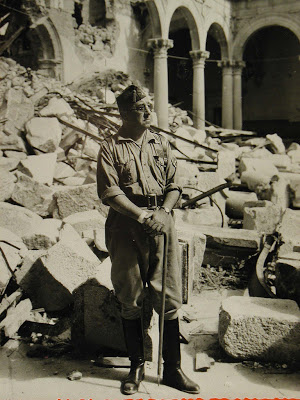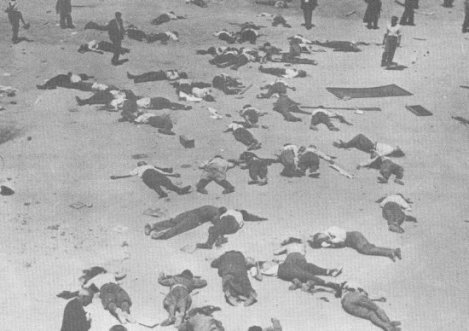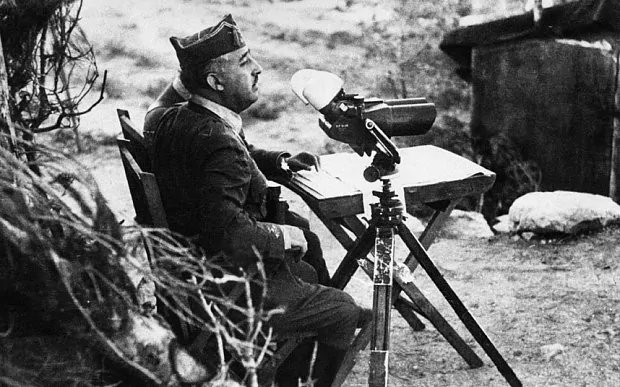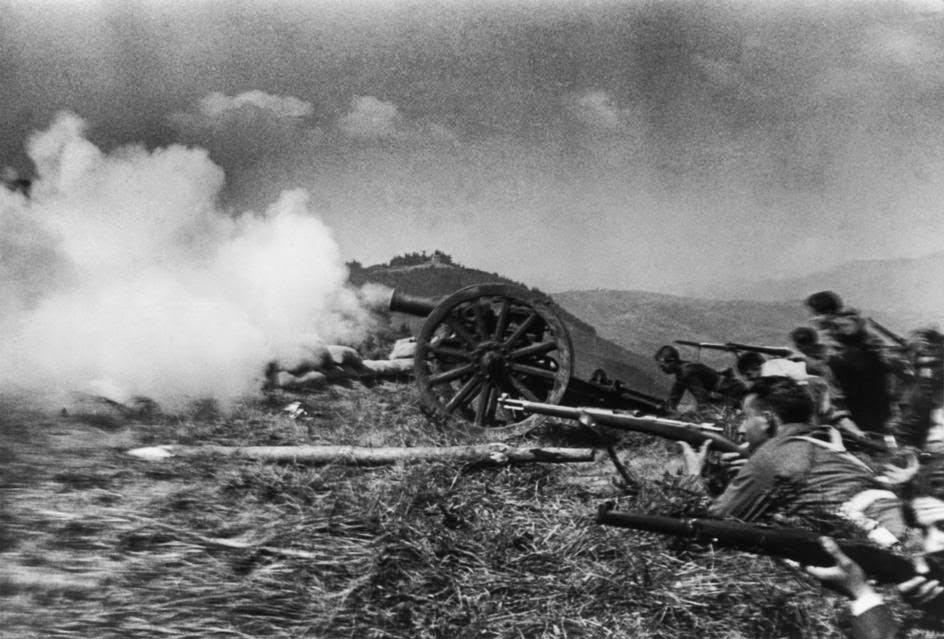July 1936. Military officers launched a coup against the liberal gov’t of Spain. The rebel Nationalists’ plans for quick victory were derailed by a coalition of loyalists and far left militias known as the Republicans. This thread will cover the Spanish Civil War& #39;s opening shots.
First, background. The Nationalists’ biggest success was securing the loyalty of the Army of Africa, Spain’s most elite military units that were stationed in Morocco. Complementing this strength were the militia forces of the fascist Falange and traditionalist Requetés.
The Republicans had little in the way of conventional forces beyond their heavily-armed political police, the Assault Guards. Nominally on their side were large anarchist and communist militia groups. Although hostile to the coup forces, they did not respond to orders well.
An early victory for the Republicans was securing most of the navy. The crews of vessels mutinied and shot their pro-coup officers, leaving the Nationalists unable to ferry their men in Africa back to Spain. However, missing officers, the Navy was not an effective combat force.
With the bulk of their forces stranded in Morocco, the Nationalists& #39; small military garrisons in major cities were quickly overwhelmed by Republican-aligned forces. The only major city taken by the Nationalists is Seville in the south, though they controlled many military bases.
By July 21, most of the Nationalists in major cities were wiped out. In Toledo, 800 military police officers, 6 cadets, 100 bureaucrats, and 200 right-wing civilians barricaded themselves in the Alcázar, a medieval fortress. They were surrounded by 8000 Republican militiamen.
Also sheltering in the Alcázar were 700 civilians, fearful of the leftist mob violence that swept many cities in Spain after the Nationalist garrisons were destroyed. The fortress’s defenders were only lightly armed with rifles, a few surplus machine guns, and hand grenades.
Toledo had an ammunition factory. Before withdrawing to the Alcázar, the military police sent the factory’s stores to the fortress. The defenders also took 100 hostages, mostly family members of prominent leftists in the town. The Republicans could not bomb them into oblivion.
As the Republicans scramble to determine which of their forces are still loyal, and to control the growing disorder in the cities, the Nationalists reach out for help. Germany and Italy provide transport planes for a huge airlift, ferrying troops out of Africa and into Seville.
The French send the Republicans surplus fighter aircraft and pilots. Both sides massacre civilians suspected of disloyalty. The main Nationalist forces are in the North, controlled by Gen. Mola, and in the South, controlled by Gen. Franco. The Republicans struggled to unify.
At the Alcázar, Republican forces begin capturing the family members of the defenders in an effort to force a surrender. The commander of the Nationalist garrison, Col. Moscardó, receives a call from his son, held at gunpoint by the commissar of the Toledo Worker’s Militia.
When his son asks how to proceed, Moscardó replies “Commend your soul to God and die like a patriot ¡Viva Cristo Rey, viva España!” His son replies “That, I can do,” before being shot in the head by the commissar. The Republicans begin artillery bombardments of the fortress.
Great Britain, France, Italy, Germany, and the Soviet Union pledge non-intervention, although this pledge is widely ignored. The Nationalists begin a mad blitz to the north. Colonel Juan Yagüe captures Badajoz from the Republicans, then massacres the 4000 surrendering defenders.
With their victory in Badajoz, the Nationalists combined their Northern and Southern forces and control the Portuguese border. A large Republican taskforce without approval from command attempts to retake Majorca, an island with a small Nationalist garrison, but are wiped out.
Communist and anarchist groups, emboldened by the weak Republican government, begin a unpopular purges in rural areas. Many farms are collectivized, the wealthy and those suspected of right-wing views are shot. Churches are burned and the graves of priests and nuns desecrated.
At the Alcázar, the Republicans tunnel beneath strategically important positions in the fortress and detonate massive bombs, known as mines. The new Republican Prime Minister, Francisco Caballero, personally activates one mine in front of journalists. The defenders hold the line.
General Franco faces a difficult choice. The road to Madrid is undefended, the Republicans in disarray. However, the defenders of the Alcázar are on their last legs. Ignoring advice from German and Italian advisors, Franco moves his forces towards Toledo to relieve the defenders.
The Soviets begin to openly sell arms, tanks, and aircraft to the Republicans. These are often accompanied by men to operate the equipment. Furthermore, they organize International Brigades, companies of foreign fighters recruited with a well-funded PR campaign across Europe.
The Republicans transfer Spain’s gold reserves to the Soviets. Anarchists are incorporated into the new Soviet-led government. The Nationalists reach Toledo and slaughter the encircling troops. Col. Moscardó, emerging from the ruins, says “Nothing to report in the Alcázar.’
General Franco’s army reaches the outskirts of Madrid. The city has been turned into a fortress. The Nationalists launch a full-scale assault with their best men. When the Republicans are on the verge of defeat, the International Brigades arrive, utterly routing the attackers.

 Read on Twitter
Read on Twitter
